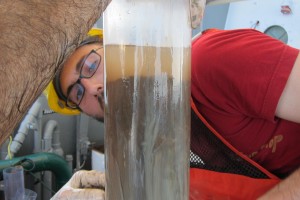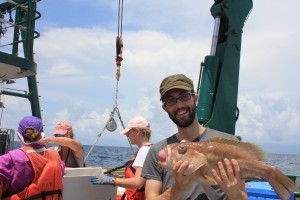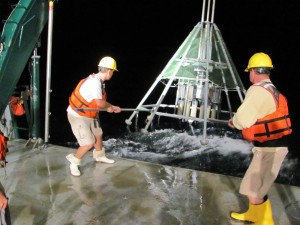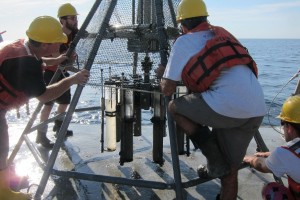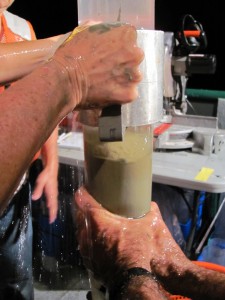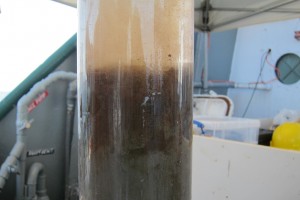Deep Sea Fish and Sediment Surveys in the Gulf
C-IMAGE voyage aboard Weatherbird II is a radio guy’s dream
My job on this voyage is to help tell the story of C-IMAGE as it works to uncover the long-term environmental impact of the Deepwater Horizon spill. Over the course of the cruise, I’ve been wielding a microphone, conducting interviews on the fly, and collecting the sounds of the ship for a series of radio pieces that will be available on the C-IMAGE website in a few months. (The scientists, I should add, have been amazingly patient and gracious as I shove a mic in their face all day long).
The Weatherbird II is a radio guy’s dream: an environment full of rich sound. In the background is a constant hum of engines, the occasional clank of a winch, the thrashing of fish and sharks as they’re pulled aboard, and the visceral crack and pop of fish skulls as they’re split open by Steve Murawski’s team of biologists during dissection. When I’m not recording these sounds, I’m pitching in with fieldwork.
-
Collecting samples while at sea is hard work, and it takes every extra set of hands available. Since I’m more of a night owl than a morning person, I’ve pulled the graveyard shift, working with geochemist David Hollander, marine chemist David Hastings, and post-doc Patrick Schwing. The three spend the wee hours of each night taking sediment samples from the ocean floor with a device called a multi-corer. It’s a metal frame that looks a bit like a giant spider with a rack with eight plastic tubes hanging within it. As the device is lowered onto the bottom, those tubes sink into the mud and silt, then seal shut to trap the sediments.
The multicore tubes have been specially built to slice into the muck, and they need to be reused each time. To save each sample, the four of us need to transfer it to another thin plastic tube with a specially built extruder (essentially a rubber cap on top of a thin metal pole). Once it’s safely inside the new tubes, we wash the original tubes and set them back onto the multicore for its next trip to the bottom.
Transferring the cores is a wet, muddy job, but it comes with moments of complete wonder. Half of each tube is filled with silt, and the other half, seawater. At the threshold between the two is an intact piece of the ocean floor, exactly as it looked more than 3,000 feet below. Occasionally, it shows evidence of tiny worms or other burrowing creatures.
Hollander and his team aren’t after these animals—they’re interested in the chemistry of the sediments, and how toxins from the Deepwater Horizon spill may have leached into the silt. Staring into the samples we bring up, however,
I find myself fixated on that tiny slice of the sea floor. Stuck in its clear plastic tube, it seems like a relic from another planet.
In its own way, I suppose, it is. Although the bottom is less than a mile away, it’s a completely alien world—harsh, inaccessible, and uninviting. But these core tubes offer us a window into that world, and place it at our fingertips for a few moments on the deck of the ship.
I can’t wait to see what tonight brings.
| Print article | This entry was posted by greely on August 17, 2012 at 6:30 pm, and is filed under Oceanic Updates. Follow any responses to this post through RSS 2.0. You can leave a response or trackback from your own site. |
